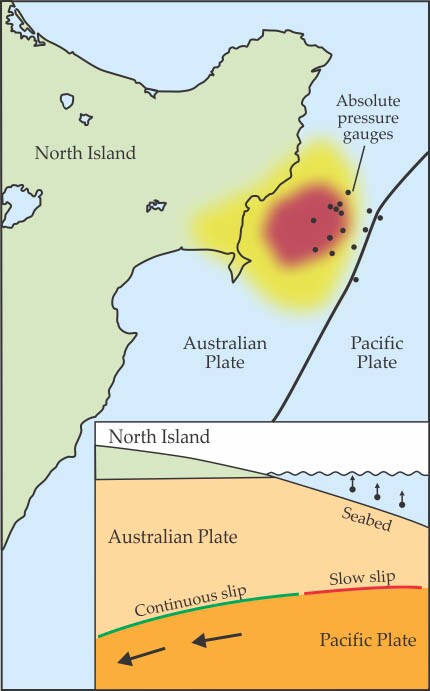Ocean pressure gauges monitor a slow-slip earthquake
DOI: 10.1063/PT.5.7269
Off the east coast of New Zealand’s North Island, two tectonic plates slowly converge, with the denser Pacific Plate diving, or subducting, beneath the more buoyant Australian Plate. Deep underground, where the plates are warmed by Earth’s mantle, they slide continuously against each other at a rate of 3–6 cm per year. Closer to the surface, the motion is more complex: The plates lock together for a year or two and then release all their accumulated strain over a period of weeks. The episodes of movement are known as “slow-slip” events, as distinguished from conventional earthquakes, which last just seconds, are rarer and larger, and occur at even shallower depths. Subduction zones around the world host similar slow-slip phenomena (see the article by John Vidale and Heidi Houston, Physics Today, January 2012, page 38
Slow slip is typically detected with networks of GPS instruments that operate with millimeter precision. In New Zealand, GPS measurements show that the Australian Plate gradually creeps westward, except during a slow-slip event, when it lurches to the east. But GPS signals can’t travel through seawater, so their measurements are limited to locations on land, which may be far from the slow-slip region itself. Now Laura Wallace
The researchers deployed an array of pressure gauges, indicated by the black dots in the figure, in May 2014 and recovered them 13 months later. After subtracting the effects of tides, ocean currents, and long-term instrumental drift from the recorded data, they found that each of the gauges on the Australian Plate had moved upward by between 1 cm and 6 cm during a three-week period in September and October; that period coincided with a slow-slip event that had been detected by GPS onshore. Surprisingly, the pressure-gauge measurements revealed that the slow-slip zone, shown approximately in red and yellow in the figure, is much shallower and closer to where the plate boundary emerges at the seafloor than was previously thought possible. The results raise the intriguing possibility of drilling to the slow-slip zone to sample the rocks that host the slow slip. (L. M. Wallace et al., Science 352, 701, 2016
